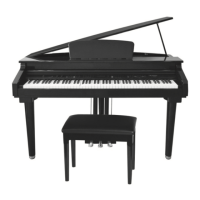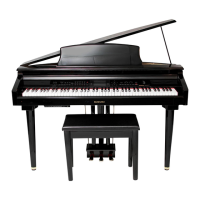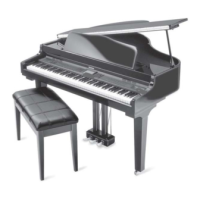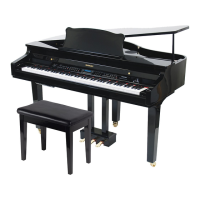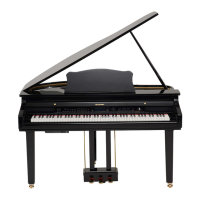
Do you have a question about the Suzuki Grande Ensemble HG-450EX and is the answer not in the manual?
| Brand | Suzuki |
|---|---|
| Model | Grande Ensemble HG-450EX |
| Category | Musical Instrument |
| Language | English |
Highlights key features of the Composer Ensemble digital piano, emphasizing advanced functionalities.
Provides essential safety information, including warnings about electrical shock and proper handling.
Instructions for piano placement, cleaning, power cord usage, and avoiding electrical interference.
Detailed steps and parts list for assembling the Grand Pianos model.
Step-by-step guide and parts list for assembling the HP-300EX model.
Details on controls like Power, Pitch Bend, Volume sliders, Demo, and MIDI.
Explanation of controls including Escape, Set Up, Screen Hold, Soft Keys, Tempo, and LCD Contrast.
Description of controls such as Grand Piano, Octave, Harmony, Drum, Voice Select, and Registration.
Explains the elements and information presented on the piano's Performance Screen.
Guide on how to select and play the piano's built-in demonstration songs.
Instructions on how to choose and change the instrument's keyboard voices.
Details on selecting different keyboard modes like Upper, Layer, Lower, and Drum.
Steps to set the split point for dividing the keyboard into different sound zones.
Guide on how to choose and activate different rhythm styles for accompaniment.
Information on adjusting tempo and using key start functions for rhythm styles.
Explanation of various chord fingering modes and their application.
Understanding Chord Hold, Auto Variation, and Fill patterns for accompaniment.
Overview of the harmony menu and how to select and engage harmony features.
Introduction to the various setup screens for configuring piano parameters.
Details on settings like Transpose, Tune, Pitch Bend Range, Split Point, and Velocity.
Configuration options for assigning functions to the piano pedals.
How to configure sustain for upper, layer, and lower keyboard sections.
Managing and storing various sound, effect, and tempo settings via registration.
Guide on selecting and controlling reverb effects for sound enhancement.
Instructions for selecting and controlling various audio effects like Chorus and Flanger.
Explanation of Real-Time, Automatic, and Step recording techniques.
Steps and soft key functions for recording performances in real-time.
Instructions for recording multiple tracks to create complex arrangements.
Techniques for recording specific sections and making corrections during recording.
Understanding the basic structure and riff components of musical styles.
Navigating the menu options for recording, editing, and managing styles.
Using the mixer screen to adjust reverb, pan, volume, and channel settings.
Working with tracks, patterns, length, quantization, and clearing data.
Editing features for modifying existing styles and their components.
Copying and managing blocks of bars within a style.
Creating and configuring new styles with various parameters.
Saving custom styles to user memory for later use.
Process for creating and recording new user styles.
Guide on loading songs and using the teacher mode for learning musical skills.
Explanation of the music games, their objectives, and skill levels.
Configuring the teacher mode with split points, volume controls, and other parameters.
Information on disk formatting, loading, saving, and managing files.
Steps to load MIDI sequences from a floppy disk into the sequencer.
How to save song sequences and user styles to a floppy disk.
Process for renaming files stored on the floppy disk.
Instructions for removing files from the floppy disk.
Guide on playing MIDI files directly from the floppy disk.
Steps to prepare a floppy disk for use by formatting it.
How to select, store, and recall registration settings for sounds and styles.
List of parameters that can be saved within registration settings.
Overview of the MIDI sequencer's capabilities, features, and file handling.
Understanding the channel and track structure within the MIDI sequencer.
How to access and utilize the MIDI sequencer's main menu functions.
Features and functions related to the track screen in the MIDI sequencer.
Editing events within the MIDI sequencer using soft keys and controls.
Detailed editing of channel track data, including position and quantization.
Editing global parameters for all tracks via the master track edit screen.
Functionality for displaying song lyrics within the MIDI sequencer.
Copying and managing track data within the MIDI sequencer.
Creating new sequences and resetting sequencer parameters.
Location of MIDI terminals and overview of the MIDI menu.
Controls and functions available on the MIDI expander screen.
Configuring MIDI input and output channels for keyboard and style.
Understanding Local control and Active Sense MIDI features.
Technical details of MIDI functions, transmitted, and recognized data.
Chart detailing MIDI expander functions, transmission, and recognition.
List of available piano voices and their MIDI program numbers.
List of available vibes voices and their MIDI program numbers.
List of available strings voices and their MIDI program numbers.
List of available organ voices and their MIDI program numbers.
List of available synth lead voices and their MIDI program numbers.
List of available sound effects and their MIDI program numbers.
List of available pop music styles.
List of available rock music styles.
List of available disco music styles.
List of available waltz music styles.
List of available swing music styles.
List of available ballad music styles.
Details of the standard drum kit and its MIDI note mapping.
Details of the power drum kit and its MIDI note mapping.
Details of the electronic drum kit and its MIDI note mapping.
Details of the jazz drum kit and its MIDI note mapping.
Explanation of the soft pedal, function pedal, and sustain pedal.
Description of headphone, audio, and MIDI connection ports.
Information on connecting a microphone to the piano.
Steps to perform a hard reset to restore factory default settings.
Detailed specifications including keyboard, recording, display, dimensions, and weight.
Information on the warranty period, coverage, and contact details.




